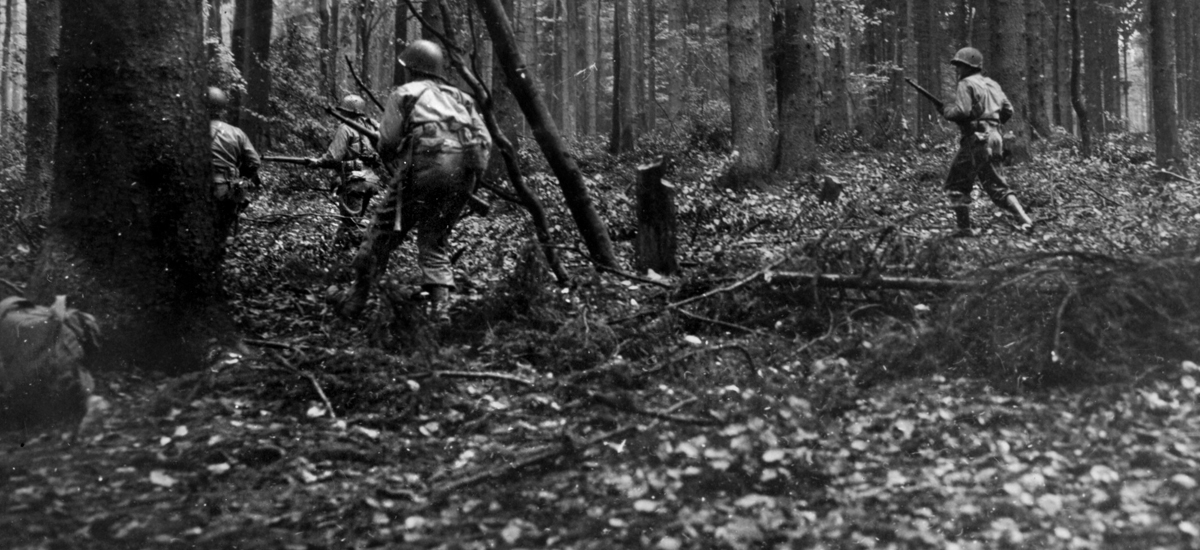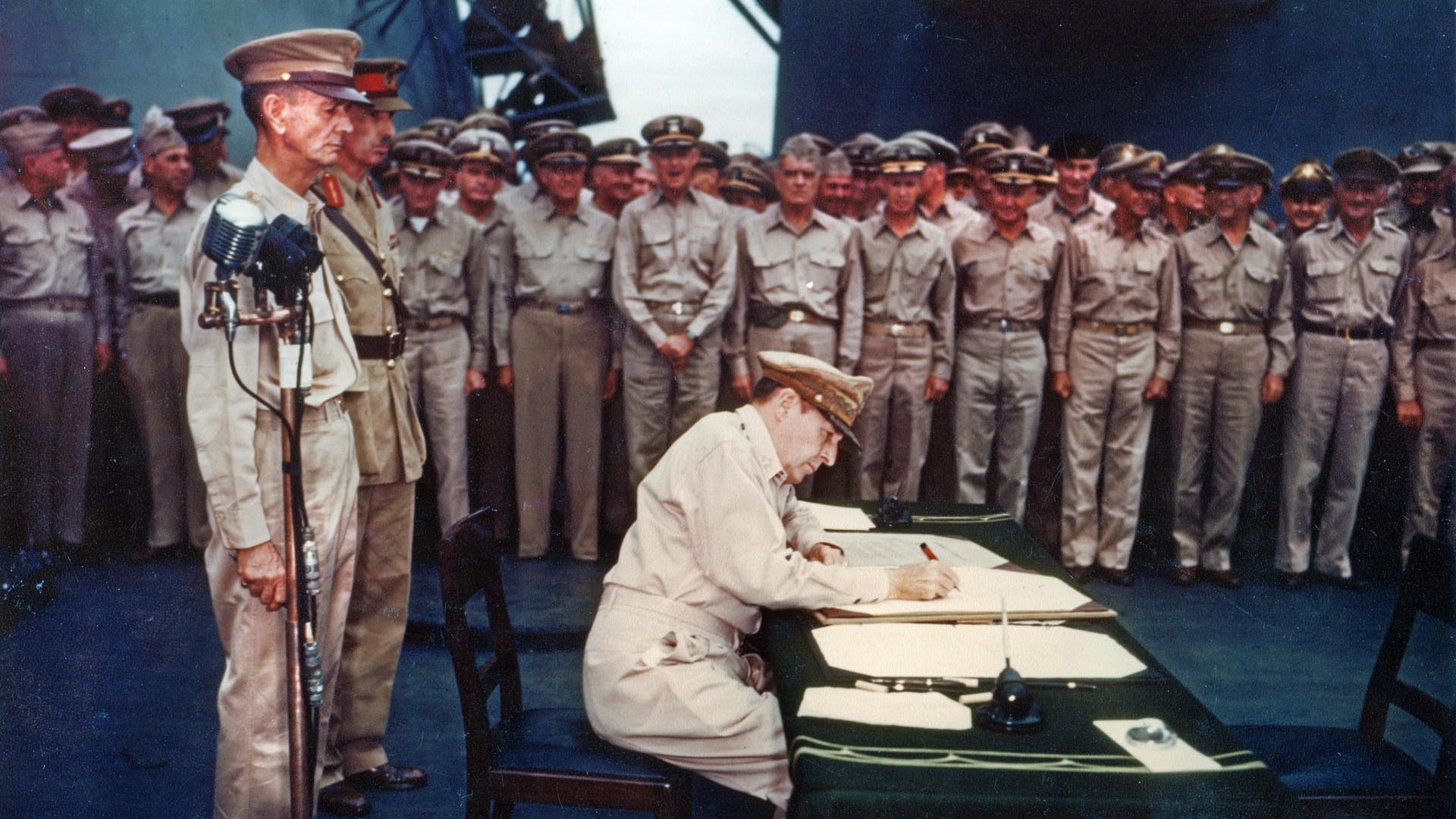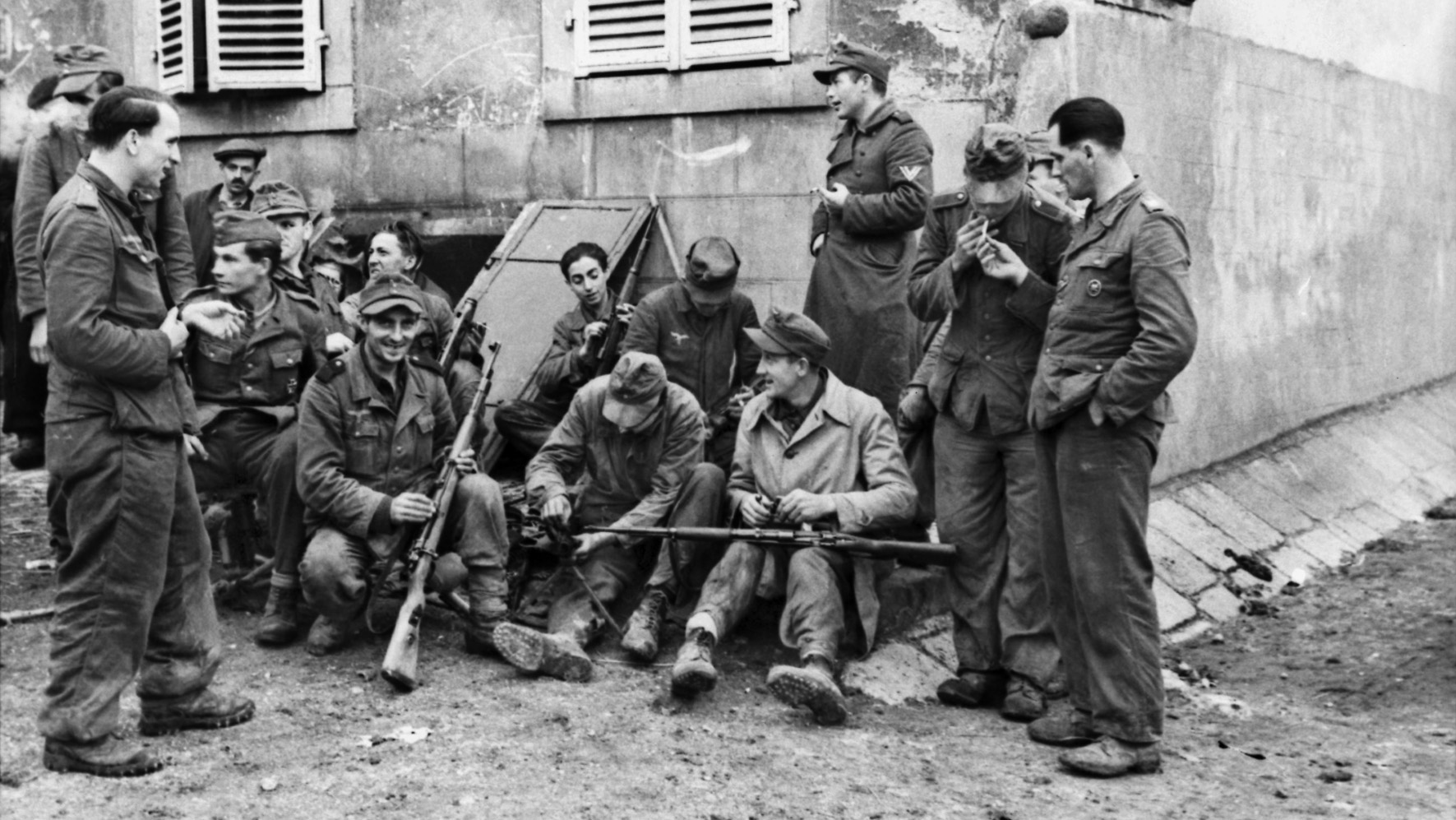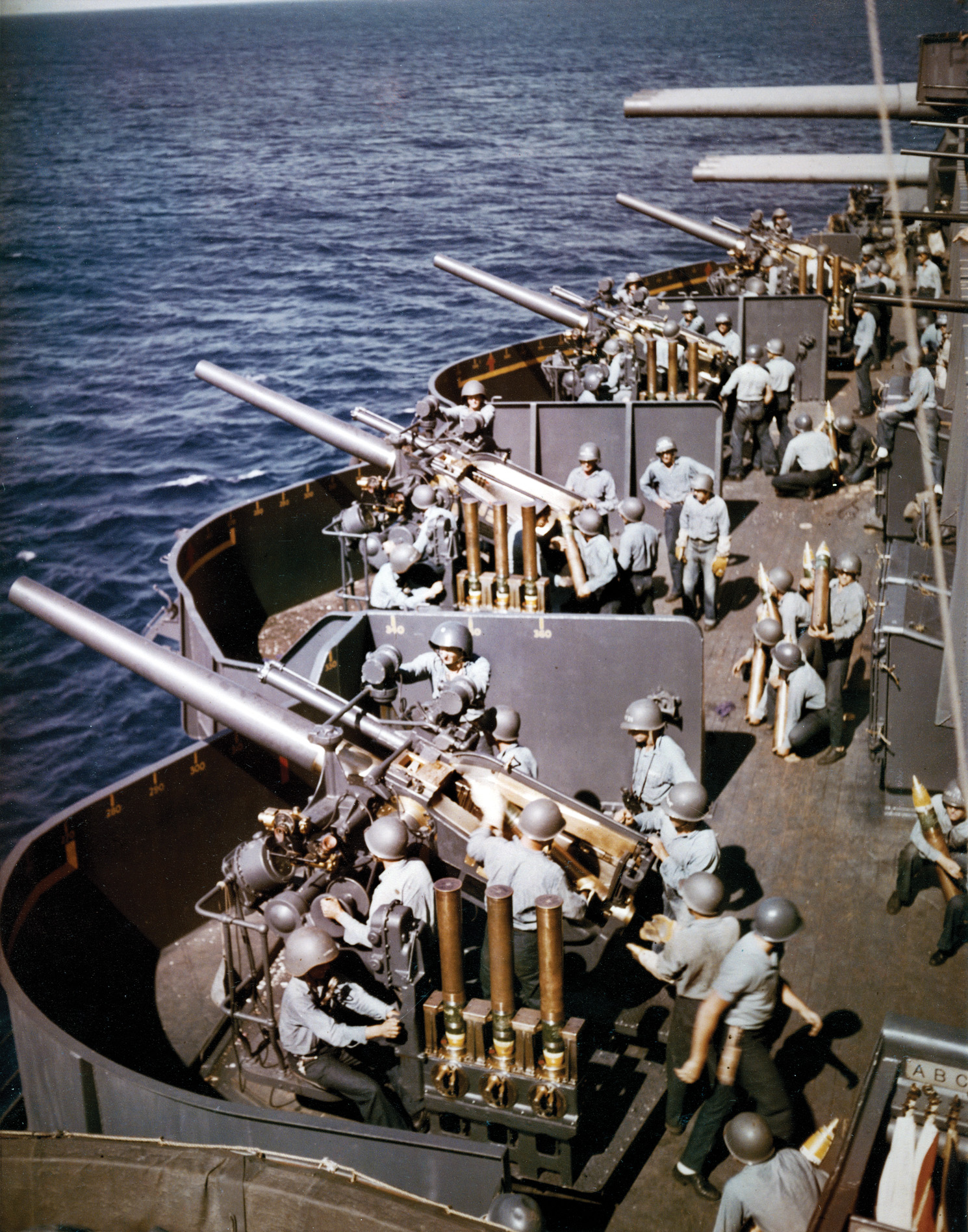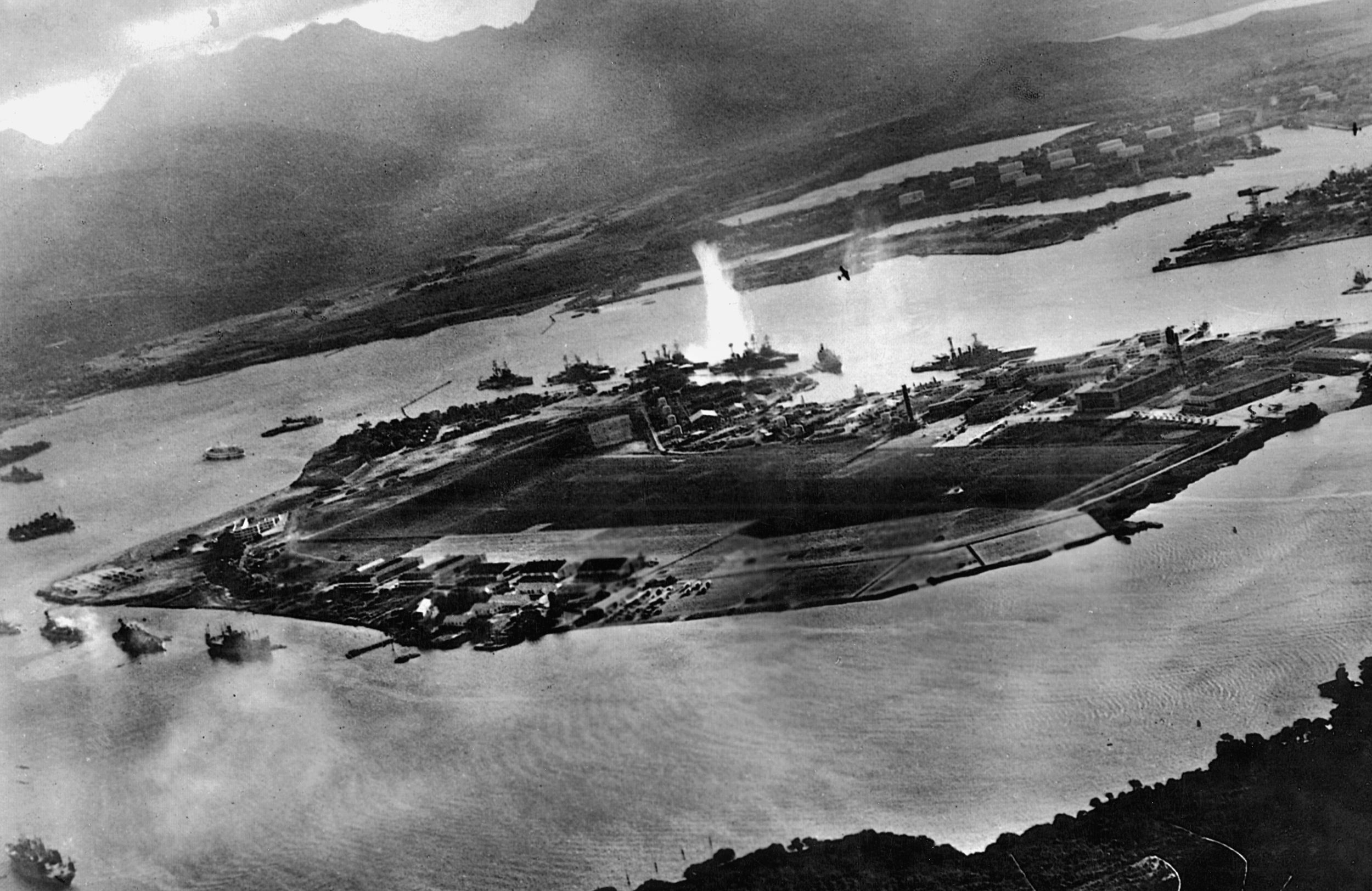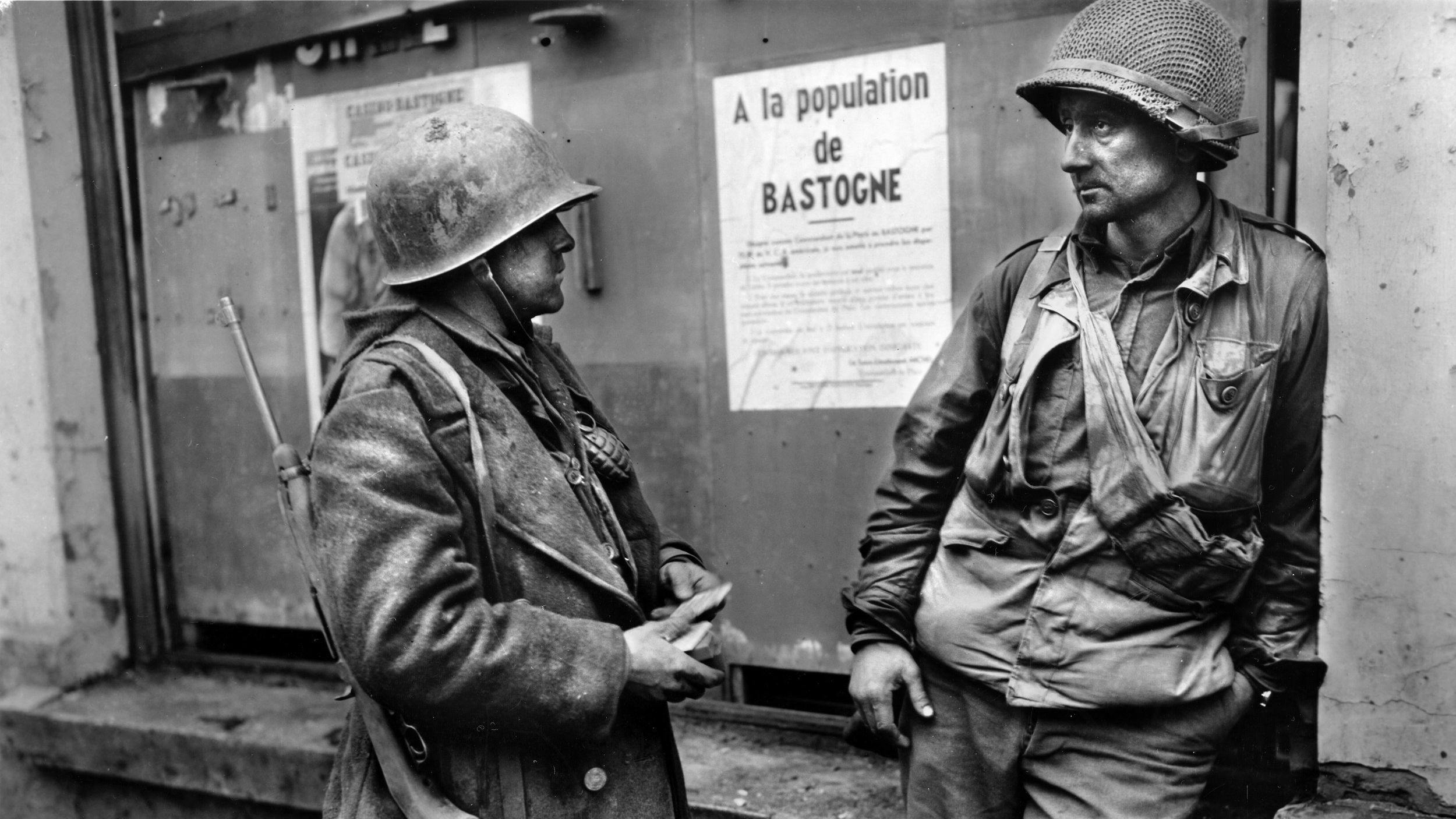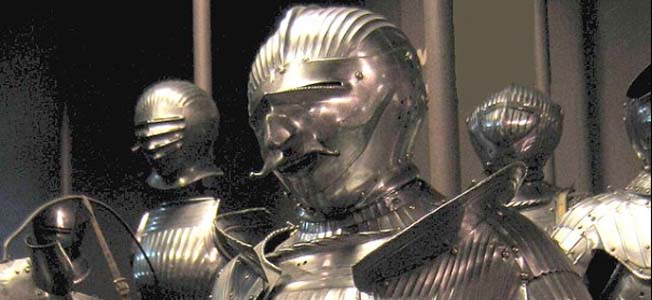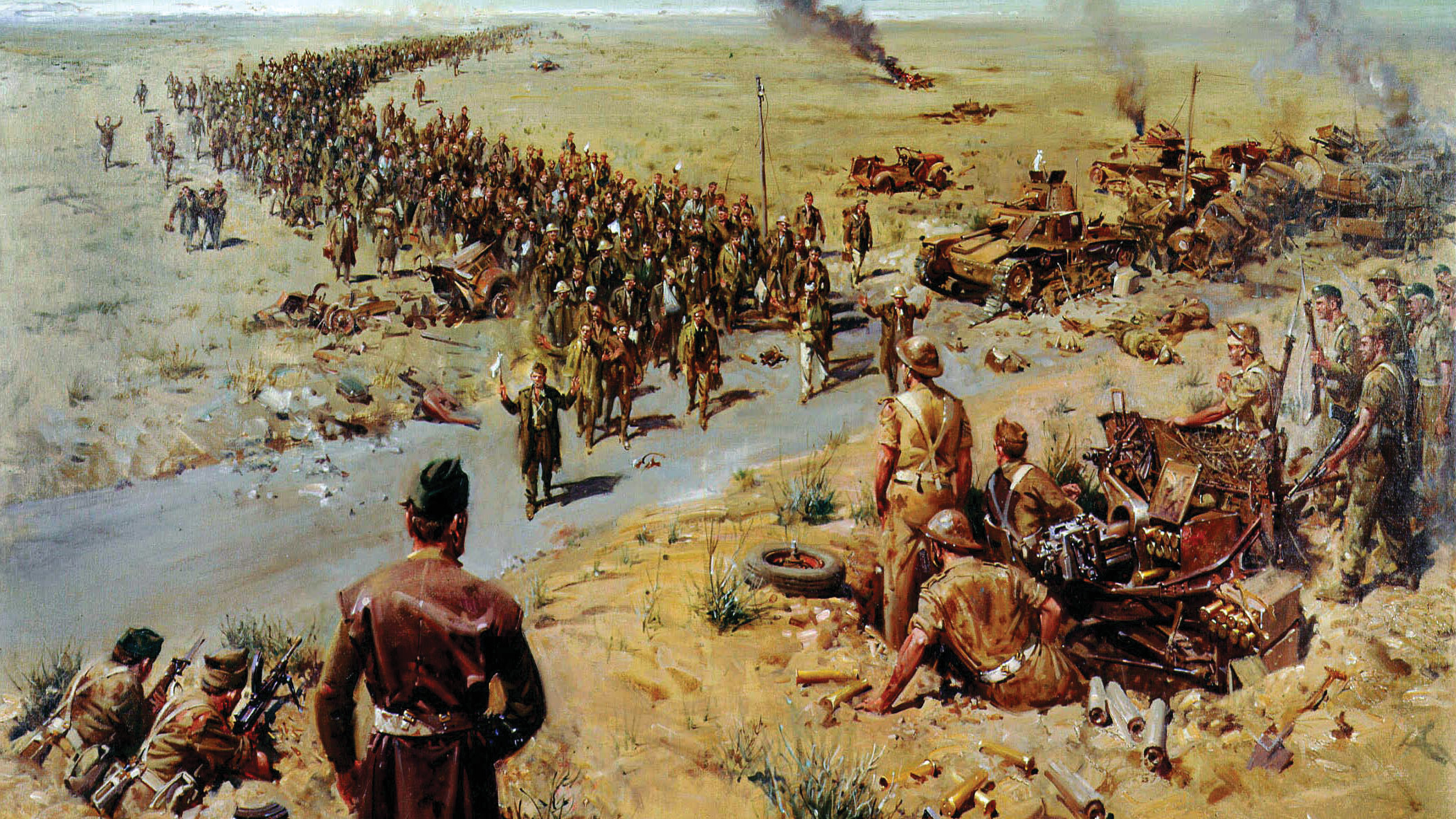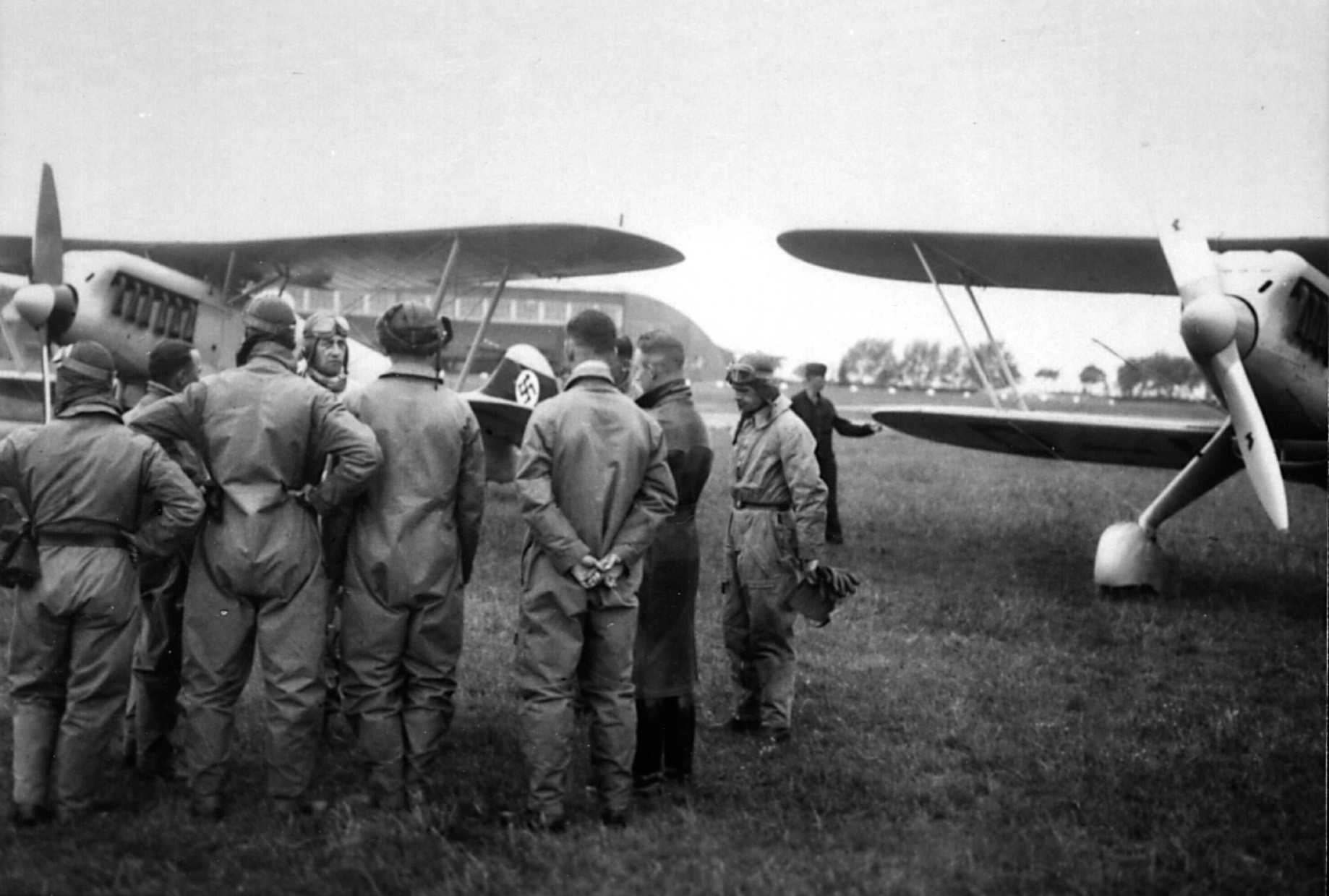By Michael D. Hull
Gray skies hung low and a steady drizzle dripped through the tall, dense fir trees near the German-Belgian border on the morning of Thursday, November 16, 1944, during the Battle of Hürtgen Forest.
As artillery volleys thumped occasionally in the distance, small groups of chilled soldiers ventured out from the forward foxholes and bunkers of German General Hans Schmidt’s 275th Infantry Division, scouting for signs of an expected American attack. Only a mile away, men of the U.S. 22nd Infantry Regiment’s rifle and weapons companies rolled up their blankets and ate breakfast. It would be their last hot meal for 18 days. Officers and sergeants made last-minute preparations for an assault.
The “Double Deucer” Regiment had landed at Utah Beach with Maj. Gen. Raymond O. “Tubby” Barton’s 4th Infantry (Ivy) Division on June 6, 1944, and suffered heavy casualties in the Normandy campaign. But, seasoned and with high morale, it was rated one of the best infantry regiments in the U.S. Army. Captain William S. Boice, one of its chaplains, called the 22nd Regiment “a fighting machine trained to an efficiency not matched at any time during the war.” Its motto was “Deeds, Not Words,” and it would be awarded a Distinguished Unit Citation.
The regiment, almost at full strength, was commanded by 42-year-old Colonel Charles T. Lanham, a wiry, graying 1924 graduate of West Point and former Infantry School instructor and War Department staffer. Also a poet and writer, his prewar work on infantry manuals had caught the attention of General George C. Marshall, and the Army chief of staff listed Lanham in his “black book” of up-and-coming officers. The scrappy Lanham led from the front to the point of foolhardiness and expected his junior officers to do the same. He told them, “As officers, I expect you to lead your men. Men will follow a leader, and I expect my platoon leaders to be right up front. Losses could be very high. Use every skill you possess. If you survive your first battle, I’ll promote you. Good luck.”
Buck Lanham’s Men Along the Three-Mile Front
Moody and prone to depression, Lanham was described by some soldiers as brilliant but “crazy as hell,” while one officer said he wanted to win the war all by himself. But there was never any question of his courage.
Stretched thinly, “Buck” Lanham’s regiment was responsible for a three-mile front in the 20-mile-by-10-mile Hürtgen Forest, situated in a 50-square-mile triangle bounded by the German cities of Aachen and Duren and the town of Monschau. There, a prolonged and bitter battle of attrition was being waged by American and German soldiers, and nowhere else on the front lines during World War II was the stamina, courage, and fighting spirit of U.S. soldiers tested more severely.
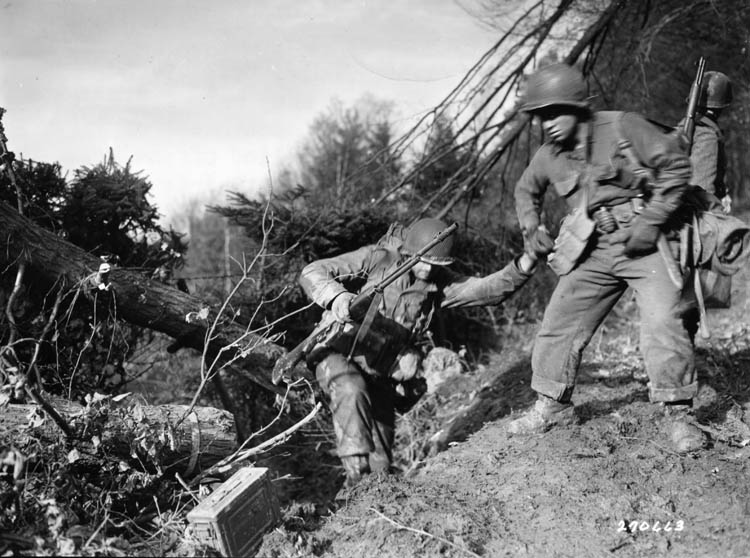
When all was ready on November 16, soldiers of the 22nd Infantry Regiment’s forward companies waded across the Roter Weh stream and began climbing a fir-clad ridge toward the Roer River plain, five miles ahead. They were starting 18 days of hell in the Hürtgen Forest “meat-grinder.” Famed novelist Ernest Hemingway, a friend of Colonel Lanham and a correspondent for Collier’s magazine, described the Battle of Hürtgen Forest as “Passchendaele with tree bursts.” He was recalling the grim Western Front battle of 1917 in which British and Canadian troops suffered 300,000 casualties in gaining a five-mile-deep salient.
Like many other units engaged, the Double Deucers fought longer than normally expected in the gloomy Hürtgenwald, and few American combat outfits have ever experienced such severe casualties. After three days, the regiment had lost its three battalion commanders, and the attrition rate among rifle company leaders was more than 300 percent. By the end of the sixth day, the regiment had suffered 50 percent casualties, the point at which an infantry unit is considered to have lost much of its effectiveness. By the night of November 20, after five days in action, the 22nd Regiment’s rifle companies had lost more than 40 percent of their strength. Then, Colonel Lanham’s men fought for another 12 days.
Despite heavy artillery support, it cost the regiment 2,806 casualties to advance 6,000 yards—averaging just over 300 yards a day—during 18 continuous days of action. One soldier fell for every two yards gained. The regiment’s casualty rate was a staggering 86 percent of its normal strength of 3,250 officers and men. And it was not alone, for several divisions and regiments were mauled in the campaign. General J. Lawton Collins, dashing commander of the U.S. VII Corps, a veteran of Guadalcanal and liberator of Cherbourg, called Hürtgen a “green hell,” while Maj. Gen. James M. Gavin, the youthful, gallant commander of the 82nd Airborne Division, characterized the forest as an “ice-coated moloch with an insatiable appetite.”
Lasting from September 1944 to January 1945, the campaign was part of a drive by the U.S. First Army, led by white-haired, dependable Lt. Gen. Courtney H. Hodges, to cross the Roer River and eventually capture its vital dams. The overall aim was an attack on the Aachen-Cologne axis designed to close with the River Rhine, as a first step toward the envelopment of the industrial Ruhr Valley. The fighting was bitter because the two forest dams controlled the water level of the Roer River flowing northward. The Allies could not launch a broad, massive attack across the Cologne Plain to the Rhine as long as the enemy held the dams and could threaten to flood the Roer River Valley.
The Roer and the Aachen Bars the Way into Germany
By September 1944, the British, American, and Canadian Armies were crowding against the borders of Germany. After the unexpected success of the Normandy breakout, the Allied high command believed that the enemy was virtually defeated. Euphoria clouded sound strategic judgment, and some rude awakenings lay ahead. The German Army was being pushed back to its home ground, but it was still a well-disciplined and formidable force. Its defenses—both natural and man-made—were strong, and it was resisting the Allied crusade more stubbornly than ever.
The rugged Vosges Mountains in northeastern France formed a traditional defensive barrier, while the Siegfried Line and the Rhine River comprised a significant obstacle to the Allied forces. The weather worsened that autumn and winter, and a series of bitterly contested battles—Walcheren Island, Aachen, the Saar Basin, the Vosges Mountains, the Reichswald Forest, and the Hürtgen Forest and the Roer River—was fought under the most trying conditions. Besides the weather, the Allied armies were plagued by shortages of ammunition and supplies.
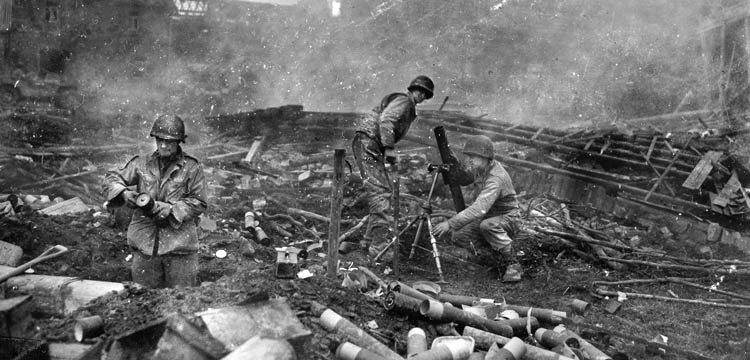
The Allied high command was eager to breach the German border defense lines, vault across the Rhine, and push into the Reich, but the way was barred by the River Roer and the large forested area south of Aachen. The corridor for advance was narrow and unsuitable for large-scale maneuvering. Nevertheless, Generals Collins and Hodges decided that it was necessary to clear the Hürtgen Forest. The former said later, “If we would have turned loose of the Hürtgen and let the Germans roam there, they could have hit my flank.”
In their haste to enter Germany, the Americans underestimated this major obstacle on the path to the Roer River, the strongly defended forest with its dense trees, deep ravines, and lack of roads. Collins and Hodges made no plans to capture the hydroelectric and flood-control dams on the river, just inside the forest. It would be too perilous to send troops across the Roer while the enemy controlled the dams. They were the key to the river, but it would take a bitter struggle in the forest by several divisions before Hodges ordered an attack against them.
The first engagements during the Battle of Hürtgen Forest were fought by Brig. Gen. Maurice Rose’s 3rd Armored Division in September 1944. It was followed by the 9th Infantry Division, the 28th Infantry (Keystone) Division, and numerous supporting units as the Americans hammered with little success against the German pillboxes and bunkers deep in the damp, gloomy forest. Reinforcing combat groups were fed piecemeal into the Hürtgen cauldron. The other units involved in the grueling campaign were the 1st, 8th, 9th, 78th, and 83rd Infantry Divisions, the 5th Armored Division, the 505th and 517th Parachute Infantry Regiments, and the 2nd Ranger Battalion, led by Lt. Col. James E. Rudder of Pointe-du-Hoc fame.
A series of attacks in the forest were ill fated, and from the beginning the campaign reflected little credit on the senior American commanders. The initial objective, to protect General Collins’ flank, was limited, and the high command failed to recognize that the Roer River dams would allow the enemy to flood any Allied advances made to the north. The Hürtgenwald was valuable territory to the Germans, and its loss would threaten their entire defense line west of the Rhine.
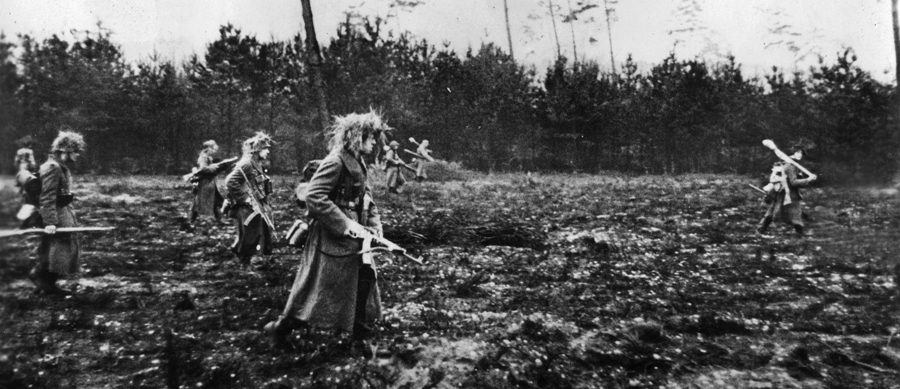
The American high command blundered by not proposing an easier avenue of approach southeast of the Hürtgen Forest, allowing Hodges’ army to seize the dams and then clear the difficult terrain downriver. The offensive as undertaken placed the American forces at a severe disadvantage in the forest. There, the Germans were able to delay and wear down the Americans, providing security and buying critical time to prepare for the Ardennes counteroffensive.
The Battle of Hürtgen Forest: A Campaign that Could (and Should) Have Been Avoided
In the Hürtgenwald, the U.S. First Army encountered a tactical nightmare. Starting on October 6, two attacking regiments had to fight for five days to advance one mile to the first clearing in the forest. The 9th Infantry Division then took 10 days of intense combat to push another mile. The two-mile advance cost almost 5,000 casualties. More divisions, including Maj. Gen. Norman “Dutch” Cota’s long-suffering 28th Infantry Division, were fed into the Hürtgenwald maelstrom, and the losses continued to mount.
The truculent Hodges did not press for air attacks on the Roer River dams until late November, but they failed. Direct hits were made, but the concrete structures were so massive that damage was negligible. On December 13, three months after the first GIs entered the Hürtgen Forest, a ground assault on the dams was launched. It would not be until February 1945 that Hodges had control of the dams and was able to confidently place troops on the eastern bank of the Roer River.
One reason for the intensity of the struggle in the forest was that the intention of General Omar N. Bradley’s U.S. 21st Army Group to reach for the strategic city of Aachen had been obvious to the enemy for some time. In the Hürtgenwald, solidly dug in with 1,000 well-concealed guns and plenty of ammunition, were the men of General Erich Brandenberger’s German Seventh Army, General Gustav von Zangen’s 15th Army, and General Hasso von Manteuffel’s Fifth Panzer Army.
The Battle of Hürtgen Forest was a campaign that could and should have been avoided—a campaign of prolonged and bitter attrition in which U.S. infantrymen were challenged by stubborn, unyielding defenders, rugged terrain, and appalling weather. Army Colonel David H. Hackworth, a distinguished battalion commander in the Vietnam War, called the Hürtgen battle “one of the most costly blunders of World War II.”
The Hürtgen campaign was strictly a foot soldier’s war because the thick, ravine-creased woods, steep ridges, lack of a road net, mud, and weather conditions—rain, fog, sleet, and snow—negated the customary American superiority in armor and air power. It was only late in the battle that U.S. tanks were able to be deployed, and it was left to the infantry to decide the battle. In the final measure, it was sheer guts rather than skill that got them through the forest. In the end, the campaign absorbed some 17 divisions, caused dreadful casualties, and proved a heavy strain on troop morale. It was one of the worst reverses for the U.S. Army in the European Theater.
American soldiers faced no greater odds under such harrowing conditions in World War II than did the riflemen, machine gunners, and mortarmen who struggled through the Hürtgenwald. “The forest up there was a hell of an eerie place to fight,” reported Technical Sergeant George Morgan, an armorer-artificer of the 1st Battalion, 22nd Infantry Regiment. “Show me a man who went through the battle and who says he never had a feeling of fear, and I’ll show you a liar. You can’t get all of the dead because you can’t find them, and they stay there to remind the guys advancing as to what might hit them. You can’t get protection. You can’t see. You can’t get fields of fire. Artillery slashes the trees like a scythe. Everything is tangled. You can scarcely walk. Everybody is cold and wet, and the mixture of cold rain and sleet keeps falling. Then they jump off again, and soon there is only a handful of the old men left.”
Colonel Lanham observed wryly, “Up there, it was our troops who combed the tree bursts out of their hair while the Kraut lay snug in his hole.”
Because it was so disastrous, and because Americans tend to remember only victories, the Battle of the Hürtgen Forest has been virtually forgotten. Overshadowed by Operation Market Garden, the Allied invasion of Holland in September 1944, and the momentous Ardennes campaign of December 1944 and January 1945, the tragic Battle of Hürtgen Forest was accorded only brief mention in the memoirs of such generals as Dwight D. Eisenhower and Omar N. Bradley and has been overlooked by most historians.
A Great Sacrifice for a Few Miles of Frozen Rubble and Swampland
When the battle finally fizzled out, all the Americans had to show for their sacrifices were a few miles of tree stumps, shell holes, shattered buildings, and swamps. British troops played a minor part in the campaign, but they were able to gain new respect for the fighting spirit and fortitude of their allies. The Battle of Hürtgen Forest echoed the horrors of the World War I killing grounds and brought much suffering to the enemy soldiers as well as the GIs. A German officer reported, “Great losses were caused by numerous frost bites. In some cases, soldiers were found dead in their foxholes from sheer exhaustion.”
The village of Hürtgen changed hands 14 times during the battle, and the village of Vossenack eight times. In at least one U.S. infantry battalion, morale cracked under the strain. In four days’ time, three company commanders lost their commands. In one rifle company, all of the officers were relieved or broke under the strain, while a platoon commander who refused to order his men into the line was put under arrest. Soldiers of all ranks broke down under the strain of continuous combat.
The Hürtgen campaign mirrored the best and the worst in the American foot soldier. Several men were awarded the Medal of Honor and the Distinguished Service Cross, and there were many other acts of gallantry that never came to light. But there were also instances in which fear paralyzed men who had seen more combat than they could stomach. Some GIs ran from their positions when the enemy was not near; others refused to move without armored support, and some tank crews would not go forward without infantry protection.
Shells bursting in the tops of the 100-foot fir trees and mines planted in the forest floor made life particularly hellish for the American infantrymen in the Hürtgen Forest. A tree burst would send steel fragments and timber raining down, and foxholes provided scant protection. Many GIs fell victim to their own artillery. The enemy troops also suffered severely from the shell bursts in the trees. General Schmidt, commander of the German 275th Infantry Division, reported, “The weird and wild surroundings intensified all combat reactions and impressions, especially since the effect of the shells exploding in the treetops was much greater due to the falling and splintering of trees and branches. Small arms fire hit trees and branches with a sharp crack, and the enemy often appeared suddenly close at hand and engaged in embittered close combat.”
Mine fields in the forest were an additional peril, and keeping safe paths through them proved difficult. Engineers marked cleared paths with white tape, but this was invariably blown away by the wind or obscured by snow and mud.
When U.S. armor was eventually brought up to support the infantry, mines and the dense trees forced the tanks to stick mainly to the few narrow, muddy forest roads and logging trails, preventing them from maneuvering. The roads were also mined, and a disabled tank or truck could block a whole column.
The Elements Were Just as Fearsome a Foe
Besides the enemy and the weather, the GIs battled exhaustion, hunger, battle fatigue, pneumonia, and trench foot. They lacked sufficient boots and winter clothing, and hot meals and a dry place in which to sleep were almost nonexistent. The men in the forward companies spent long nights, half frozen in open foxholes with only their uniforms for protection. Much to the surprise of British troops in the area, the GIs were forced to subsist on cold C-rations. Many went without hot food for days on end.
One British Army officer reported, “What surprised us was the apparent indifference of the American commanders to the physical needs of their men in winter warfare. In these conditions, hot food once a day is as vital as ammunition. In the first few days, the infantry of the 84th Division were expected to exist on packets of odd items such as eggs and bacon compressed into tablets, gum and candy, with nothing hot to drink. Men fight with greater cheerfulness even on the cheapest form of pig’s belly of transatlantic origin masquerading as bacon, if hot, or the bully beef and tea and biscuits which maintained the British. They also need a pair of dry socks every day.”
The 84th Division suffered 500 casualties from trench foot.
Before the Battle of Hürtgen Forest and the campaigns of the winter of 1944-1945, no American soldiers had suffered such hardships as did the men in that nightmarish forest. Overcoats soaked with moisture and caked with frozen mud became too heavy to wear. Rain seeped into radios and rendered them useless, and the forest floor was so tangled with brush and debris that men broke under the physical strain of carrying weapons, moving supplies forward, and evacuating the wounded.
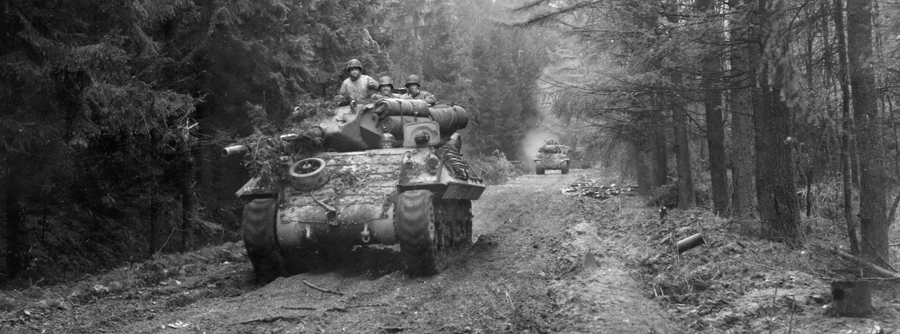
The fighting was often at such close quarters that hand grenades were the only decisive weapons. Booby traps in abandoned foxholes and ditches turned promised sanctuaries into graves for the unwary. The Germans sometimes planted explosives underneath wounded men; one GI lay motionless for 72 hours, struggling to remain conscious so that he could warn whoever might come to his rescue. Meanwhile, as the living strove to survive, the bloated, frozen bodies of the dead lay strewn in grotesque positions.
“The toll was staggering,” reported one American survivor of the Hürtgenwald campaign. “By mid-December, the three line companies of my armored infantry battalion had left only four officers and 170 enlisted men; at full strength, its complement was 18 officers and 735 enlisted men. Commanders of the three line companies had been either killed or wounded.”
The slaughter and misery dragged on well into December 1944, when the Americans were ordered to pull out of the forest. Some did not withdraw until Christmas Eve. By that time, all attention from the Allied high command on down was fixed upon the debacle caused by Field Marshal Gerd von Rundstedt’s great breakthrough in the Ardennes on December 16.
General Bradley’s Major Blunder
At least 120,000 U.S. troops took part in the Battle of Hürtgen Forest, and an estimated 24,000 were killed, wounded, or captured. Combat fatigue, pneumonia, and trench foot claimed another 9,000 men.
When the appalling losses were revealed, some participants and high-ranking officers, both American and German, questioned the necessity of the campaign and regarded it as a major blunder on the part of General Bradley. Blame for the initial reverses, panic, and confusion in the Battle of the Bulge had also been laid at his door. The critics questioned Bradley’s wisdom in choosing to make his main effort through the Hürtgenwald instead of using the more open, easier going farther north on the Ninth Army front between the U.S. First and British Second Armies. The hapless Bradley responded cryptically, “You don’t make your main effort with your exterior force.”
Lieutenant Frank L. Gunn, commander of the 2nd Battalion, 39th Infantry Regiment, which captured the village of Merode, said, “In retrospect, it seemed to me that the Hürtgen Forest could have been contained rather than assaulted, and a large flanking or encircling movement performed by corps. This would have reduced the casualties and still have accomplished the mission of capturing the dams on the Roer River.”
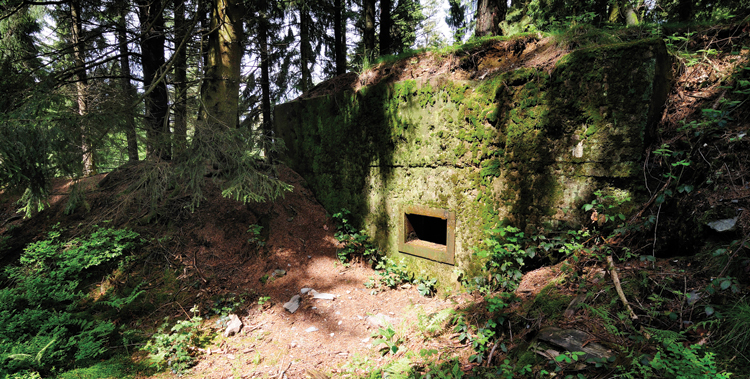
Lieutenant William Burke, a company commander in the 803rd Tank Destroyer Battalion, agreed: “Some of us with combat experience from the beaches to Hürtgen were hard pressed to understand the tactical wisdom of slogging it out in such an unforgiving environment instead of bypassing it.”
Major General Rudolph Gersdorff, chief of staff of the German Seventh Army, was quoted as saying, “The German command could not understand the reason for the strong American attacks in the Hürtgen Forest.… The fighting in the wooded area denied the American troops the advantages offered them by their air and armored forces, the superiority of which had been decisive in all the battles waged before.”
Ironically, some experts saw the disastrous Battle of Hürtgen Forest as having unintended consequences beneficial to the American cause. The bloodletting, particularly the fight around the villages of Hürtgen, Kleinhau, and Grosshau, may have altered the outcome of the Battle of the Bulge by presenting a strong shoulder that the German Sixth Panzer Army never broke. If the U.S. effort had bypassed the Hürtgenwald to the north in November 1944, it was reasoned, the forest could have served both as a hinge on which the German counteroffensive would pivot in December and as a natural shield to benefit the enemy.
Ill conceived in the Allied high command’s haste to reach the gates of Nazi Germany, the Hürtgen Forest campaign was a strategic blunder that could have been avoided—a five-month waste of American lives and resources.
Yet, despite the many hardships and appalling losses, the U.S. infantry there were able somehow to maintain unit integrity and to persevere. While criticism fell inevitably upon the high command, there was no questioning the heroism and determination of the GIs in the foxholes.
The historian of the crack British Guards Armored Division, which exchanged officers and men with the Americans, reported, “Their [the Americans’] methods might be somewhat curious and unorthodox, but there could be no doubt about the excellent results when put into practice. Divisions such as the 29th and 30th Infantry which fought in this battle could have challenged comparison with the finest of our own.”
Echoes of the Great War
The costly Battle of Hürtgen Forest seriously weakened Hodges’ First Army, with its extended front line unable to resist the German onslaught in the early hours of the Battle of the Bulge. The Big Red One and 9th Infantry Divisions had to depend almost entirely on replacements after Hürtgen, and the 4th and 8th Infantry Divisions also had big manpower gaps to fill. The 2nd Ranger Battalion and the 517th Parachute Infantry Regiment emerged from the bloody forest as skeletal units. General Cota’s 28th Division was trying to recover and regroup in the town of Wiltz in northern Luxembourg when it was struck by von Rundstedt’s advance columns on December 16.
The Battle of Hürtgen Forest was replayed a few weeks later, shortly before the end of the European war, in the Battle of the Reichswald as Field Marshal Bernard L. Montgomery’s British 21st Army Group closed to the River Rhine. There, in a large tract of gloomy forest southwest of Cleves in Westphalia, troops of the 2nd Canadian Division and five British Army divisions had to battle through five German defense lines on a narrow, flooded front. Part of Monty’s Operation Veritable, the offensive in the Reichswald—the northern anchor of the Siegfried Line—kicked off on February 8, 1945, and involved fierce fighting in heavy rains. Despite support by artillery and Royal Air Force bombers, progress was slow and the casualties heavy. The forest was not cleared until March 9.
Like the Hürtgen campaign, the Reichswald struggle bore marked similarities to the grim fighting on the Western Front in 1914-1918 and has been overlooked by most historians.
Author Michael D. Hull was a frequent contributor to WWII History. He resided in Enfield, Connecticut.
